As a cat lover, I have often wondered why my feline companion feels the need to touch my face with their nose. This adorable behavior is not only endearing but also intriguing. To truly understand why cats engage in this behavior, we must delve into the fascinating world of feline behavior, affection, communication, and bonding. Join me on this comprehensive exploration as we uncover the reasons behind your cat’s nose-touching antics.
Key Takeaways:
- Cats touch your face as a sign of affection and love.
- Scent marking is another reason behind this behavior.
- Cats use nose-touching to satisfy their curiosity and explore.
- They might be seeking attention or initiating interactive play.
- Respecting a cat’s personal space is crucial.
Cats Touching Your Face: An Act of Affection
One of the most adorable behaviors that cats display towards their owners is touching their face with their nose. This gentle and affectionate gesture is a sign of love and bonding between cats and their human companions. When your cat reaches out and touches your face, it is their way of expressing their affection and desire to be close to you.
When a cat touches your face with their nose, it is a form of communication. The nose-to-nose contact is a way for cats to exchange scents and establish a sense of familiarity and belonging. It is their unique way of saying, “You are mine, and I am yours.” This act of affection strengthens the bond between you and your cat, creating a deeper connection and sense of trust.
Not only is face-touching a sign of affection, but it is also an indication that your cat respects your personal space. Cats are naturally independent creatures, and their ability to show affection without invading your boundaries is a testament to their understanding of your comfort level. By touching your face gently and delicately, they are acknowledging your presence while still maintaining a respectful distance.
To further demonstrate their affection, cats often accompany face-touching with other behaviors such as purring and slow blinks. These additional gestures convey their contentment and relaxation in your presence. It is their way of saying, “I feel safe and happy with you.” So the next time your cat reaches out and touches your face, cherish this special moment of bonding and know that you are deeply loved.
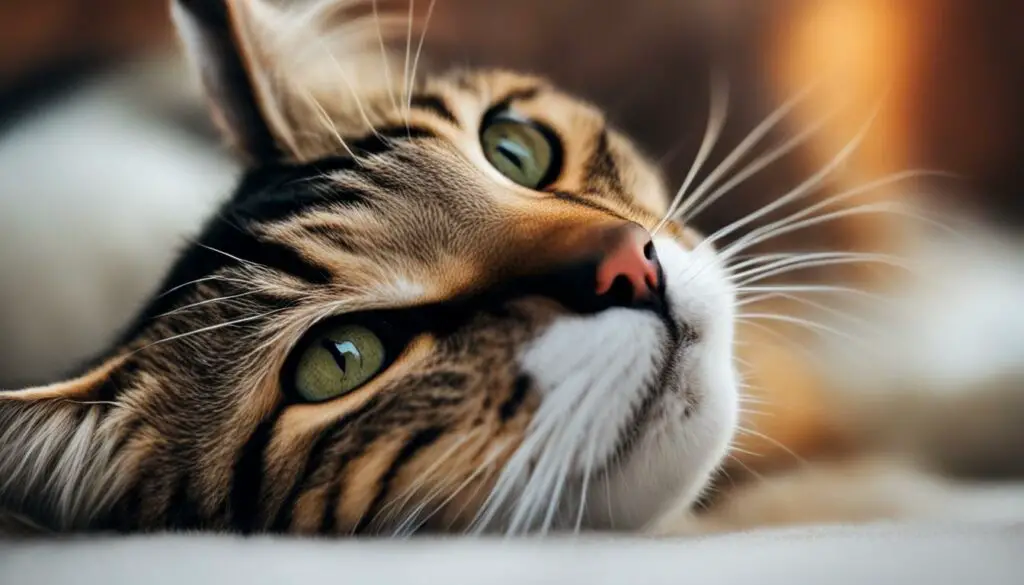
Table: Behaviors Associated with Cats Touching Your Face
| Behavior | Meaning |
|---|---|
| Purring | Contentment and relaxation |
| Slow blinks | Trust and affection |
| Gentle pawing | Playfulness and interaction |
| Rubbing against your face | Scent marking and ownership |
Remember, each cat is unique, and their behavior may vary. While some cats may be more inclined to touch your face as a sign of affection, others may show their love in different ways. Pay attention to your cat’s individual preferences and enjoy the special bond you share. After all, the love and affection of a cat are truly one of life’s greatest gifts.
Scent Marking through Face Touching
Cats have a fascinating way of communicating with others through scent. One of the ways they do this is by touching your face with their nose. This behavior is a form of scent marking, as cats have scent glands in their paws that release pheromones. By touching your face, they are effectively marking you as part of their territory and showing that you belong to their family. It’s their way of saying, “You are one of us”.
This scent marking behavior is rooted in a cat’s instinctual need to establish their territorial boundaries and communicate with other cats. By marking you with their scent, they are creating a sense of familiarity and belonging. It’s their unique way of claiming you as their own and reinforcing the bond between you.
While scent marking through face touching may seem peculiar to us, it is an important aspect of feline behavior. It helps to establish a sense of security and territory, both for the cat and for you as their owner. Understanding and appreciating this behavior can deepen your understanding of your cat’s needs and strengthen the bond you share.
| Benefits of Scent Marking through Face Touching | Purpose |
|---|---|
| Establishing territorial boundaries | To mark you as part of their family and territory |
| Creating a sense of familiarity | To reinforce the bond between you and your cat |
| Enhancing communication with other cats | By leaving their scent on you, they can communicate their presence to other cats |
So, the next time your cat touches your face with their nose, appreciate the unique way they are expressing their love and belonging. It’s a special moment that reinforces the bond you share and allows your cat to communicate with you and the world around them.
Curiosity and Exploration: Unveiling the Playful Side of Cats
Curiosity is an inherent trait in cats, fueling their desire to explore the world around them. This natural instinct drives them to touch your face with their nose, engaging their sense of smell and satisfying their inquisitive nature. By using their keen olfactory senses, cats can discover new scents and experiences, providing them with mental stimulation and entertainment.
As curious beings, cats thrive on sensory exploration, and touching your face is just one way they engage with their environment. Their sensitive noses allow them to gather information about their surroundings, detecting subtle scents and textures that often go unnoticed by our human senses. This sensory exploration not only satisfies their curiosity but also enhances their understanding of the world, helping them navigate and adapt to different situations.
“Curiosity is the very core of human existence, and it’s what keeps us pushing forward.” – Leonardo DiCaprio
During their playful escapades, cats use facial touch as a means of discovery and interaction. By gently touching your face, they can elicit a reaction from you, initiating a playful game of chase or stimulating interactive play. This behavior showcases their natural inclination for exploration and their desire to engage in dynamic and stimulating activities.
To encourage your cat’s curiosity and support their exploration, create an enriching environment filled with interactive toys, scratching posts, and hiding spots. Provide them with opportunities to discover new scents and textures, stimulating their natural curiosity and keeping them physically and mentally engaged. By embracing and nurturing their curious nature, you can foster a deep and fulfilling bond with your feline companion.
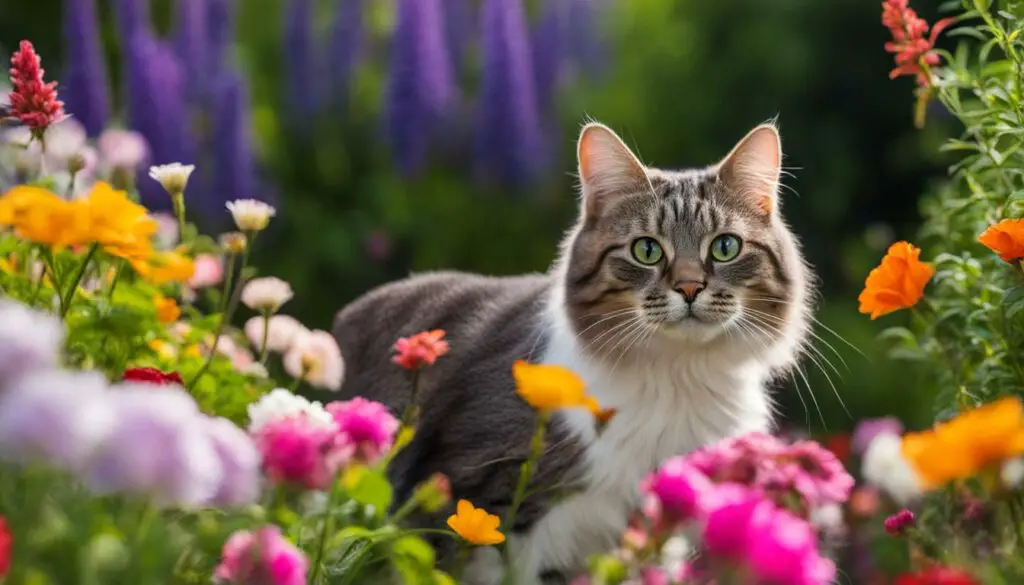
The Benefits of Curiosity and Exploration for Cats
Curiosity and exploration play a vital role in a cat’s well-being. By encouraging their natural instincts, you can provide them with numerous benefits, including:
- Physical exercise: Engaging in exploration and play helps cats stay active and maintain a healthy weight.
- Mental stimulation: Curiosity-driven activities keep cats mentally sharp, preventing boredom and promoting overall cognitive function.
- Stress relief: Exploration allows cats to release pent-up energy and reduce anxiety, leading to a more relaxed and contented state.
- Bonding opportunities: Participating in interactive play and exploration strengthens the bond between you and your cat, creating a deeper connection based on trust and shared experiences.
Embrace your cat’s natural curiosity and join them in the exploration. Together, you can embark on exciting adventures, create lasting memories, and build a stronger bond that will enrich both of your lives.
Section 5: Seeking Attention
Cats are known for their independent nature, but they also crave attention and interaction with their human companions. One way they seek attention is by touching your face. By gently pawing at your face, meowing, or purring, they are trying to communicate their desire for playtime or interaction. It’s their way of saying, “Hey, pay attention to me!”
When a cat touches your face to seek attention, it’s important to respond in a positive and engaging manner. Take a few moments to interact with your cat, whether it’s through play, petting, or simply talking to them. This will not only fulfill their need for attention but also strengthen the bond between you and your feline friend.
Table: Examples of Cat Attention-Seeking Behaviors
| Behavior | Description |
|---|---|
| Pawing at Face | Cat gently touches your face with their paw to get your attention. |
| Meowing | Cat vocalizes to grab your attention and initiate interaction. |
| Purring | Cat purrs while rubbing against you to show their desire for attention. |
| Headbutting | Cat bumps their head against yours as a sign of affection and a request for attention. |
Remember, each cat has their unique way of seeking attention. Some may be more vocal, while others may prefer physical touch. Take the time to understand and respond to your cat’s individual preferences. By meeting their emotional needs for attention and play, you’ll create a harmonious and fulfilling relationship.
The Playful Behavior of Cats
When it comes to cats, their playful behavior is one of the most endearing traits that they possess. Through interactive play, cats not only entertain themselves but also strengthen the bond they share with their human companions. Playfulness is an essential aspect of a cat’s nature, and it allows them to express their innate curiosity and explore their surroundings.
During playtime, cats often engage in various behaviors that showcase their playfulness and desire for interaction. They may swat, paw, or gently touch your face as a way to initiate games. This behavior is a clear indication that your cat sees you as a companion and wants to engage in a fun activity together.
To encourage playfulness and bonding with your cat, it is important to provide them with toys and interactive games that stimulate their natural instincts. Incorporating activities that involve chasing, pouncing, and hunting can help satisfy their playfulness and keep them physically and mentally stimulated. By participating in these play sessions, you are not only providing entertainment but also deepening the bond you share with your feline friend.
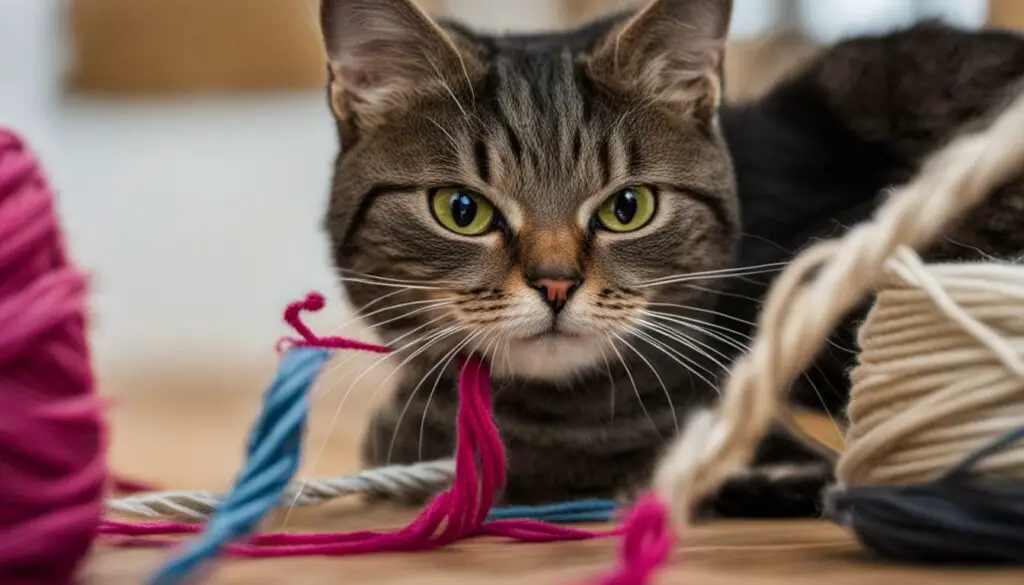
Benefits of Playful Interaction
Engaging in playful interaction with your cat offers numerous benefits for both you and your furry companion. Besides strengthening the bond between you, playtime helps channel your cat’s energy in a positive way, reducing the likelihood of destructive behavior. Playing with your cat can also provide mental stimulation, which is essential for their overall well-being.
Furthermore, interactive play allows you to observe your cat’s behavior closely, helping you understand their individual preferences and needs. Through play, you can learn more about your cat’s personality and build a deeper connection with them. So, whether it’s through chasing a ball, dangling a toy, or engaging in a game of hide-and-seek, make sure to set aside dedicated playtime to nurture the playful spirit of your feline companion.
| BENEFITS OF PLAYFUL INTERACTION |
|---|
| Strengthens the bond between you and your cat |
| Channels your cat’s energy in a positive way |
| Reduces the likelihood of destructive behavior |
| Provides mental stimulation for your cat |
| Helps you understand your cat’s individual preferences and needs |
Respect Their Personal Space
When your cat touches your face with their nose, it’s important to understand and respect their personal space. Just like humans, cats have boundaries and a need for privacy. When a cat exhibits negative body language, such as hissing, growling, or having their ears back while touching your face, it’s a clear indication that they want their personal space respected.
Personal space is crucial for cats as it allows them to feel safe and secure. By respecting their boundaries, you can build trust and strengthen your bond with your feline friend. Giving them the space they need shows that you understand and care for their well-being.
It’s essential to pay attention to your cat’s body language and respond accordingly. If your cat displays signs of discomfort or stress while touching your face, gently move away and give them the space they require. This will help create a harmonious environment and ensure a positive interaction between you and your cat.
In conclusion, respecting your cat’s personal space is vital for maintaining a healthy and balanced relationship. By understanding their body language and boundaries, you can build trust, strengthen your bond, and provide a comfortable environment for your feline companion.
Not All Cats Do This
While many cats exhibit the adorable behavior of touching their owner’s face with their nose, it is important to note that not all cats engage in this behavior. Cats, like humans, have unique personalities and behaviors that vary from one individual to another. Just as not all humans express their affection in the same way, cats also have different ways of showing their love and affection.
Some cats may prefer to show their affection through purring, kneading, or rubbing against their owners. Others may choose to curl up next to their owners or follow them around the house. Each cat has its own preferred method of expressing love and bonding with their human companions.
It is essential for cat owners to respect and appreciate their cat’s individuality. Understanding and accepting that not all cats engage in the behavior of touching their owner’s face with their nose is crucial for maintaining a strong and healthy relationship. Instead of focusing on what a cat does not do, it is more rewarding to appreciate the unique ways in which they express their love and affection.
| Individuality and Personality in Cats |
|---|
| “Every cat is unique, and their behaviors and preferences can vary greatly. Just like humans, cats have different temperaments, preferences, and comfort levels. Some cats may be more social and affectionate, while others may be more independent or reserved. It is important to understand and respect a cat’s individuality and personality, as this will help foster a strong bond between the cat and its owner.” |
By acknowledging and embracing the individuality of our feline companions, we can cultivate a deeper understanding and appreciation for their unique qualities. It is through this understanding that we can build a strong and lasting bond with our cats based on mutual respect and love.
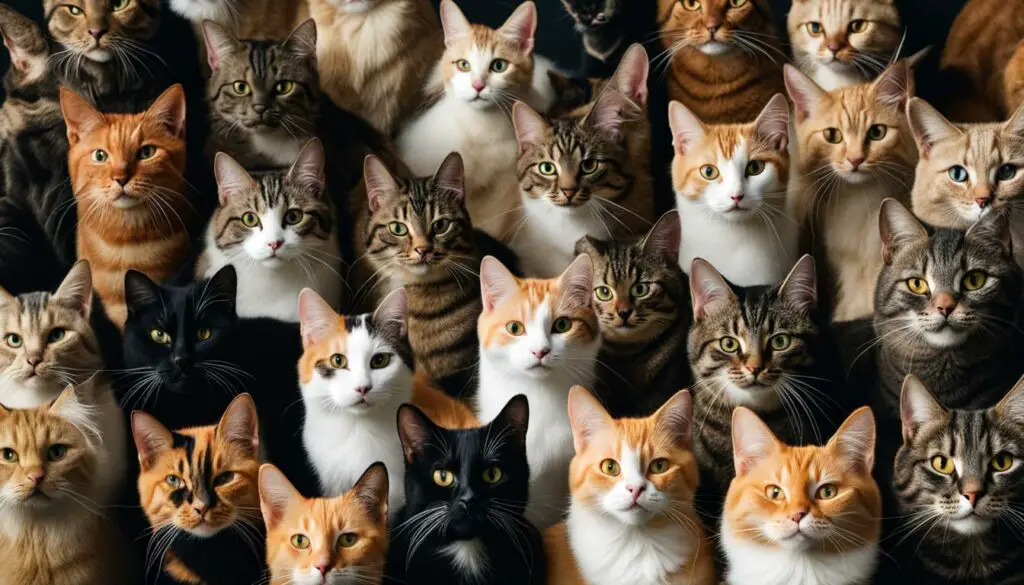
The Significance of a Cat’s Sense of Touch
A cat’s sense of touch is an essential and remarkable aspect of their sensory abilities. This unique sense plays a crucial role in their daily activities, allowing them to navigate their environment with precision and gather valuable sensory information. Cats possess various touch receptors that enable them to interact with the world around them in extraordinary ways.
One of the most prominent features of a cat’s sense of touch is their whiskers. These specialized hairs, located on either side of their face, serve as highly sensitive touch receptors. Whiskers provide cats with crucial information about their surroundings, helping them gauge distances accurately and navigate tight spaces. When a cat touches your face with their nose, they are not only expressing affection but also engaging their whiskers to gather sensory information and establish a connection.
Additionally, cats have touch receptors on their paws and nose. These receptors are particularly sensitive to different textures and temperatures, allowing cats to explore their environment with precision. When a cat gently touches your face with their nose, they are using these touch receptors to gather information about your scent, temperature, and texture. It is their way of connecting with you on a sensory level and understanding more about their human companions.
Cats’ Extraordinary Sensorial Abilities
Cats possess remarkable sensorial abilities that contribute to their unique interactions with humans. From their taste sense to their sophisticated sense of touch, cats have evolved extraordinary sensory adaptations that enhance their understanding of the world around them. Let’s explore these fascinating abilities in more detail.
The Taste Sense of Cats
While humans can taste sweet flavors, cats lack the genetic ability to detect sweetness in food due to the absence of the sweet gene. However, their taste buds are highly attuned to other flavors, particularly those that are meaty or savory. This adaptation is a result of their natural carnivorous diet, which requires them to have a heightened sensitivity to protein-rich foods. Cats’ taste preferences reflect their evolutionary history and their nutritional needs.
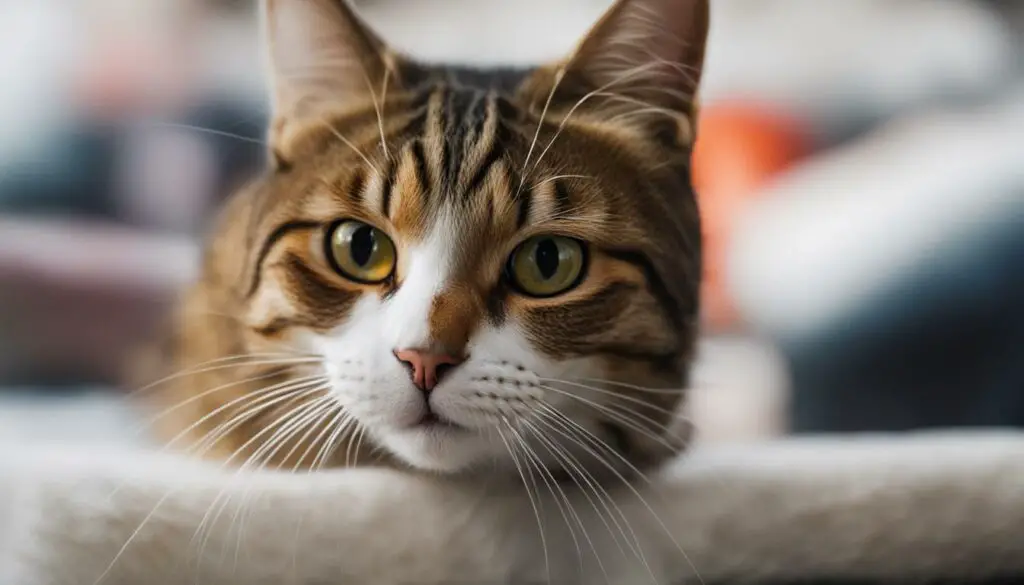
Whiskers and Sensory Information
Whiskers, also known as vibrissae, are another vital sensory tool that cats possess. These specialized hairs are found on the muzzle, above the eyes, and on the backs of their front legs. Whiskers are incredibly sensitive and provide cats with valuable information about their surroundings. They act as tactile sensors, helping cats navigate through narrow spaces, detect air movements, and determine the size and shape of objects. Whiskers also play a crucial role in hunting, allowing cats to judge the distance and movement of their prey with great accuracy.
The Controversial “Sixth Sense”
While there is ongoing debate about whether cats possess a true sixth sense, they do exhibit behaviors that suggest an uncanny ability to perceive subtle changes in their environment. For example, cats have been known to anticipate their owners’ arrival, even before they hear or see any physical cues. This heightened awareness may be attributed to their acute senses and their ability to pick up on subtle changes in sound, odor, and energy. Whether it is a true sixth sense or simply an exceptional ability to interpret sensory information, cats’ perceptiveness adds to their mystique and allure.
“Cats possess extraordinary sensorial abilities, including their unique taste sense and sophisticated sense of touch.”
In addition to their extraordinary sensorial abilities, cats’ keen senses contribute to their emotional well-being. Their acute awareness of their environment allows them to engage in activities that bring them joy, such as hunting, exploring, and playing. By nurturing their sensory experiences and providing an enriching environment, cat owners can promote their feline companions’ overall emotional health and happiness.
In summary, cats’ sensorial abilities, including their refined taste sense, whiskers, and potential sixth sense, contribute to their unique interactions with the world and their human counterparts. Understanding and appreciating these remarkable adaptations can deepen our connection with cats and enhance our mutual well-being.
The Role of Cats in Pet Therapy
Pet therapy has become increasingly popular in providing emotional support and therapeutic benefits to individuals in need, including autistic children and dementia patients. Cats, with their unique abilities and innate empathy, play a significant role in these therapy programs, forming a deep emotional connection with those they interact with.
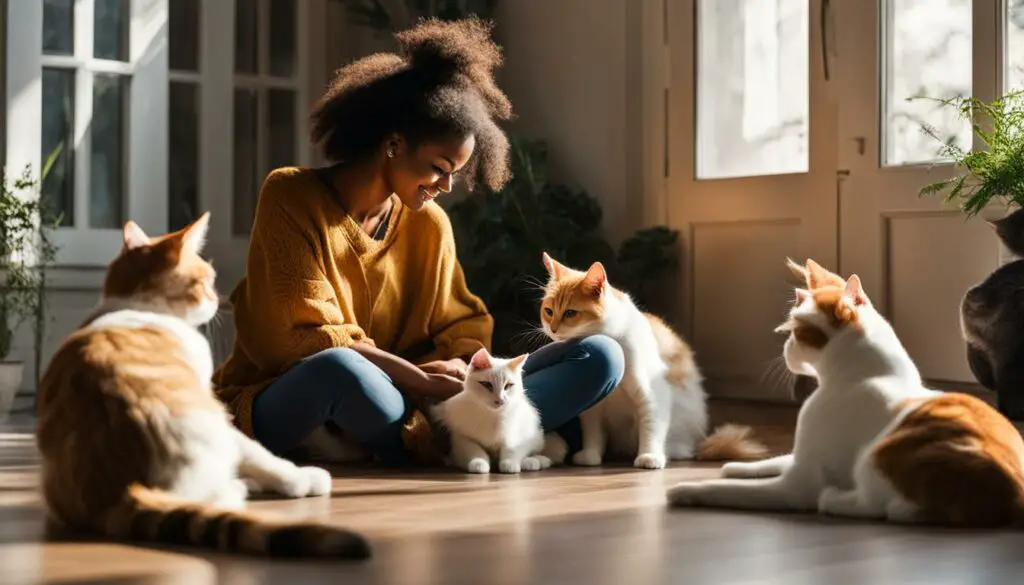
Interacting with cats during therapy sessions has been shown to have a transformative impact on individuals. Autistic children, for example, often struggle with social communication and sensory integration. The presence of a cat can help create a calm and comforting environment, reducing anxiety and promoting social interaction. The non-judgmental nature of cats allows these children to feel accepted and understood, facilitating their emotional development and social skills.
In the case of dementia patients, cats provide a source of companionship and emotional support. These individuals may experience feelings of loneliness, confusion, and agitation. Petting and interacting with cats can evoke positive emotions, improving their mood and reducing stress. The sensory experience of touch and the soft purring sounds of a cat can provide a soothing effect and increase feelings of comfort and well-being.
While the concept of a cat’s sixth sense may be debated, the positive impact they have in pet therapy programs cannot be denied. Cats possess an inherent ability to connect with humans on an emotional level, offering unconditional love and companionship. Their presence alone can create a sense of joy, warmth, and comfort, providing therapeutic benefits to those in need.
Cats Touching Your Face: An Expression of Affection, Communication, and Bonding
When your beloved feline companion reaches out and touches your face with their nose, it is a heartwarming gesture that conveys a multitude of emotions. This behavior, often observed in cats, holds significance in their unique way of communicating and strengthening the bond with their human counterparts. Let’s explore the various reasons why cats touch your face and the profound meaning behind this tender act.
An Act of Affection and Love
One of the primary reasons cats touch your face with their nose is to express affection and love. This gentle gesture, accompanied by purring and slow blinks, is a clear indication that your cat trusts you and desires closeness. It is their way of showing you that you hold a special place in their heart and that they are content in your presence.
By initiating physical contact through face-touching, cats establish a stronger emotional connection with their owners. This act of affection creates a sense of security and reinforces the bond between human and feline, fostering a deep and meaningful relationship.
Scent Marking and Territoriality
Another reason cats touch your face is to engage in scent marking. Cats have scent glands on their paws that release pheromones, which serve as a means of communication with other cats. By gently tapping your face, your cat is marking you as part of their territory and signaling to other felines that you are a cherished member of their family.
Through this behavior, cats are demonstrating their ownership and protective instincts, further solidifying their bond with you. It is a way for them to mark you as a familiar and cherished part of their lives.
Seeking Attention and Playfulness
Touching your face can also be your cat’s way of seeking your attention and initiating playtime. Cats are naturally curious creatures and thrive on interactive engagement. By softly pawing or gently tapping your face, they are effectively communicating their desire for interaction and play.
This behavior presents an opportunity for you to engage with your cat through games and play, strengthening the bond between you two. Taking the time to play and provide enriching experiences for your feline friend will not only fulfill their need for stimulation but also deepen the affectionate connection you share.

| Reasons for Cats Touching Your Face | Synopsis |
|---|---|
| An Act of Affection and Love | Expressing love and trust through gentle face-touching, purring, and slow blinks |
| Scent Marking and Territoriality | Marking you as part of their territory and signaling your belonging to their feline family |
| Seeking Attention and Playfulness | Communicating their desire for interaction and engaging in playful activities |
Additional Ways to Strengthen Your Bond with Your Cat
Building a strong bond with your cat is a rewarding and fulfilling experience. It requires time, patience, and a deep understanding of your furry friend’s needs. Here are some additional ways you can strengthen the bond between you and your cat:
1. Provide Proper Care
Caring for your cat’s physical and emotional well-being is essential for a strong bond. Make sure to provide a balanced diet, regular veterinary care, and a clean and comfortable living environment. Regular grooming sessions, such as brushing their coat and trimming their nails, can also be a bonding opportunity.
2. Engage in Interactive Play
Playtime is not only fun for your cat but also a great way to strengthen your bond. Use interactive toys, such as feather wands or puzzle feeders, to engage their natural hunting instincts. Take the time to play with them daily, offering plenty of physical and mental stimulation.
3. Understand Their Individual Needs
Every cat is unique, with their own preferences and quirks. Take the time to observe and understand your cat’s behavior. Are they more social or independent? Do they enjoy cuddling or prefer their personal space? By respecting their individual needs, you can create a safe and trusting environment, strengthening your bond.
4. Communicate through Body Language
Cats communicate through body language, and understanding their signals can help deepen your connection. Pay attention to their tail position, ear movements, and facial expressions. Respond to their cues and provide positive reinforcement when they display behaviors you appreciate. This will help build trust and strengthen your bond over time.
By following these additional ways to strengthen your bond with your cat, you can create a loving and lasting relationship. Remember, each cat is unique, so be patient and adaptable in your approach. Enjoy the journey of building a strong cat-human bond!
FAQ
Why do cats touch your face with their nose?
Cats touch your face with their nose for various reasons, including affection, scent marking, curiosity, seeking attention, and playfulness.
Is it a sign of love when a cat touches your face?
Yes, when a cat gently touches your face, purrs, and makes slow blinks, it is a sign of affection and love. It signifies a strong bond between you and your cat.
Why do cats touch your face with their nose during playtime?
Cats may touch your face during playtime as a way to initiate interactive play. It is their expression of playfulness and their desire to bond with you through interactive games.
What should I do if my cat touches my face and exhibits negative body language?
If your cat touches your face while exhibiting negative body language such as hissing or growling, it is important to give them space and respect their boundaries. They may be communicating that they want their personal space respected.
Do all cats touch their owner’s face with their nose?
No, not all cats engage in this behavior. Cats have unique personalities and behaviors, and their expression of love and affection may vary. Whether or not your cat touches your face does not reflect their love for you; it simply means they have different ways of showing their affection.
What is the purpose of a cat’s whiskers and touch receptors?
Whiskers serve as touch receptors, helping cats navigate their surroundings and measure distances accurately. Touch receptors on their nose and paws enhance their sense of touch and allow them to gather sensory information through their fur.
Do cats have a sixth sense?
The existence of a sixth sense in cats is controversial. While there may not be solid evidence of a sixth sense, cats have the ability to form deep emotional connections with humans and provide therapeutic support.
How can cats contribute to emotional well-being?
Cats have been found to have a transformative impact when paired with autistic children or dementia patients in pet therapy programs. The presence of a cat can enhance emotional well-being and improve the lives of those they interact with.
How can I strengthen the bond with my cat?
Building a strong bond with your cat goes beyond understanding their behavior. You can enhance the cat-human relationship by providing proper care, engaging in interactive play, and understanding their individual needs.
Source Links
- https://cats.com/why-does-my-cat-put-their-paw-on-my-face
- https://www.purina.co.uk/articles/cats/kitten/play/cat-senses
- https://www.purina-arabia.com/articles/cats/kitten/play/cat-senses








